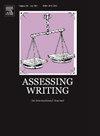以需求为导向的综合读写测验评等量表设计
IF 5.5
1区 文学
Q1 EDUCATION & EDUCATIONAL RESEARCH
引用次数: 0
摘要
为配合高等教育的发展趋势,高等教育专业进修课程设有问责制,为学生接受高等教育的机会作准备和评估。因此,包括综合写作(IW)评估在内的多模式任务已经复苏,因为它们可以说是学术写作的密切反映。然而,由于测试的实用性、限制以及这些评估的使用和格式的可变性,评级表往往无法证实国际信息战评估的核心主张。考虑到读写要求和IW测试的实证研究,我们开发了一个综合读写量表,旨在评估一年级人文和社会科学课程的准备情况。我们将测试开发作为正在进行的验证工作的一部分,详细说明规模开发过程中涉及的考虑因素。我们认为,与学术写作要求保持一致应该指导IW测试的发展,从而承认和理解学术写作的细微差别。本文从一开始就演示了规模设计中的考虑和决定,作为验证过程,这提醒我们评估不仅仅是一个定量的练习,而是一个多方面的过程。本文章由计算机程序翻译,如有差异,请以英文原文为准。
Designing a rating scale for an integrated reading-writing test: A needs-oriented approach
To meet the current trends in higher education, there is accountability on EAP programmes to prepare and assess students’ access to higher education. Thus, multimodal tasks including integrated writing (IW) assessments have seen a resurgence because they arguably closely mirror academic writing. However, test practicality constraints and variability in the use and format of these assessments mean rating scales often fall short in substantiating the central claims of IW assessment. We developed an integrated reading-writing scale taking into account reading-writing requirements and empirical research on IW tests designed to assess readiness for first-year humanities and social science courses. We approached test development as part of the ongoing validation efforts, detailing the considerations involved in the scale development process. We argue that alignment with academic writing requirements should guide the development of IW tests, thereby acknowledging and comprehending nuances of academic writing. The paper demonstrates considerations and decisions in scale design as the validation process from the start, which is a reminder that assessment is not just a quantitative exercise but a multifaceted process.
求助全文
通过发布文献求助,成功后即可免费获取论文全文。
去求助
来源期刊

Assessing Writing
Multiple-
CiteScore
6.00
自引率
17.90%
发文量
67
期刊介绍:
Assessing Writing is a refereed international journal providing a forum for ideas, research and practice on the assessment of written language. Assessing Writing publishes articles, book reviews, conference reports, and academic exchanges concerning writing assessments of all kinds, including traditional (direct and standardised forms of) testing of writing, alternative performance assessments (such as portfolios), workplace sampling and classroom assessment. The journal focuses on all stages of the writing assessment process, including needs evaluation, assessment creation, implementation, and validation, and test development.
 求助内容:
求助内容: 应助结果提醒方式:
应助结果提醒方式:


